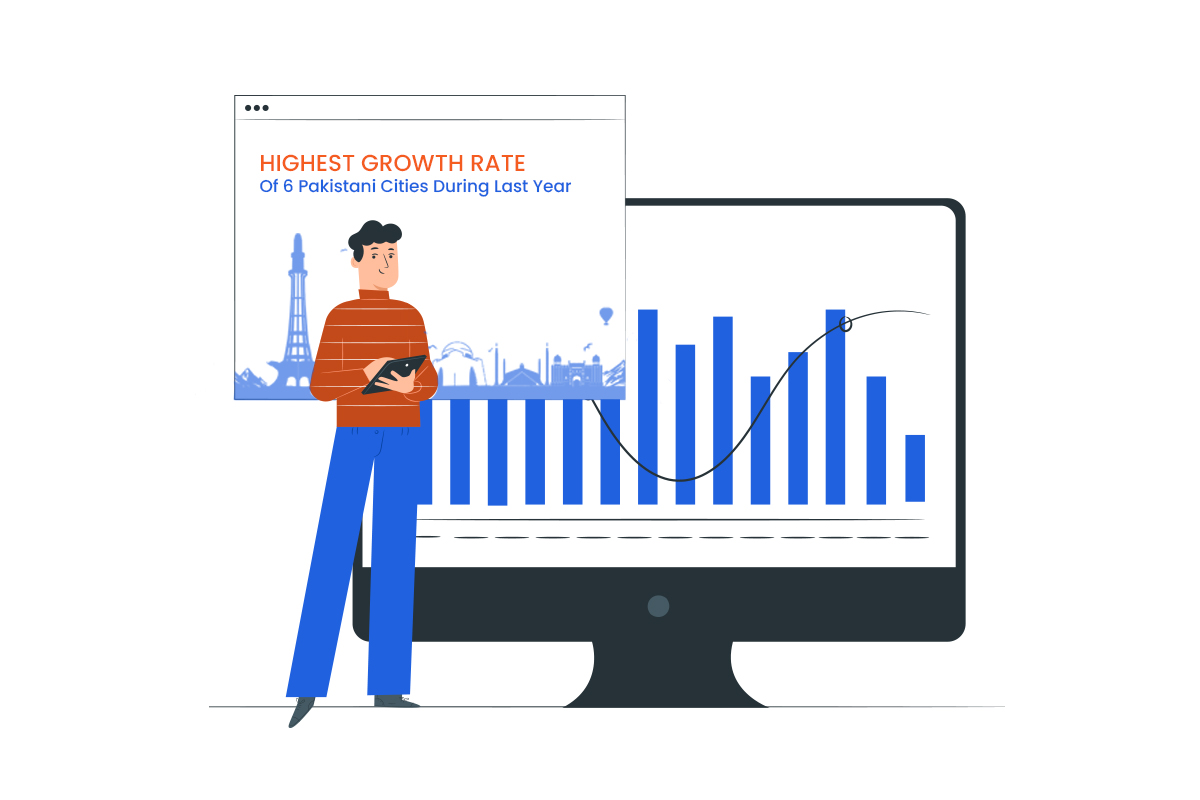There are about 20 cities that have a population of one million or more. Among the twenty-five, most prominent cities in the world are Karachi and Lahore. Pakistanis are moving to cities faster than any other nation in South Asia due to their rapidly expanding urban population. As a result, only ten cities now house a fifth of Pakistan’s population. According to interpolation of the most recent United Nations data, Pakistan had a population of 231,612,266 on December 30, 2022. The Pakistani cities that have grown in the last few years are listed below.
Fastest growing Regions of Pakistan in the Last few Years
Six Pakistani cities that have seen the highest growth rate are.
[su_icon_text icon=”icon: circle-thin” icon_color=”#2917ec”]Peshawar[/su_icon_text] [su_icon_text icon=”icon: circle-thin” icon_color=”#2917ec”]Karachi[/su_icon_text] [su_icon_text icon=”icon: circle-thin” icon_color=”#2917ec”]Lahore[/su_icon_text] [su_icon_text icon=”icon: circle-thin” icon_color=”#2917ec”]Faisalabad[/su_icon_text] [su_icon_text icon=”icon: circle-thin” icon_color=”#2917ec”]Rawalpindi[/su_icon_text] [su_icon_text icon=”icon: circle-thin” icon_color=”#2917ec”]Gujranwala[/su_icon_text]
[su_icon_text color=”#F45C20″ icon=”icon:fort-awesome” icon_color=”#2061DF” icon_size=”32“]Peshawar[/su_icon_text]
The Peshawar City Development Strategy (CDS), created in less than two years, assisted in establishing a long-term vision that was centered on institutional growth and enhanced governance.
The strategy was primarily designed to respond to citizens’ everyday issues. By utilizing already-existing institutions and resources more effectively, it sought to create an environment that would support urban development. The three critical pillars of the Peshawar CDS were capacity building, enablement, and good governance. Concerning Afghanistan and the Central Asian Republics, Peshawar has served as a crucial trade hub.
It had been supplying the massive influx of Afghans with equipment following the Afghan War (1979–1989) and during the Taliban regime. The urban population of Peshawar is increasing quickly, from 8% in 1981 to 14% in 2017 and 18% in 2030.
[su_icon_text color=”#F45C20″ icon=”icon:plane” icon_color=”#2061DF” icon_size=”40″]Karachi [/su_icon_text]
Karachi is home to 24% of Pakistan’s urban residents and 9% of the nation’s total population. Additionally, the city contributes 15% to the national GDP, 25% to revenues, and 62% to income tax. In southern Pakistan’s Sindh province, Karachi is situated along a natural port on the Arabian Sea. The people living in the city are very diverse.
According to the GaWC index, Karachi is Pakistan’s principal financial and transportation hub and is ranked as a Beta world city. There are many different developments in the city. Karachi will be the seventh most populated city in the world in 15 years.
[su_icon_text color=”#F45C20″ icon=”icon:train” icon_color=”#2061DF” icon_size=”35″]Lahore [/su_icon_text]
Lahore is a well-liked tourist destination because it is regarded as the cultural hub of Pakistan. It has industrial areas and is Pakistan’s second-largest financial center. The city is the largest software production hub in the nation and is home to a flourishing computer assembly sector and numerous historical structures, gardens, and monuments. Lahore has a long history dating back more than 2000 years and is referred to as the “cultural heart of Pakistan.” With a population of 12 million, Lahore is a significant hub for culture and education. It is also a center for financial and IT services.
[su_icon_text color=”#F45C20″ icon=”icon:industry” icon_color=”#2061DF” icon_size=”35″]Faisalabad[/su_icon_text]
After Karachi and Lahore, respectively, Faisalabad has the third-highest population in Pakistan.
[su_icon_text color=”#F45C20″ icon=”icon:road” icon_color=”#2061DF” icon_size=”35″]Rawalpindi[/su_icon_text]
Due to their close social and economic ties, Rawalpindi and Islamabad, the capital of Pakistan, are collectively referred to as the “twin cities” and one of the fastest-growing cities in Pakistan in the last few years. It is the third-largest city in Punjab after Lahore and Faisalabad and the fourth-largest city in Pakistan after Karachi, Lahore, and Faisalabad.
The town is a popular destination for tourists and is also the location of ancient palaces and temples. In addition, the city is home to many suburban housing developments that act as bedroom communities for Islamabad workers. Rawalpindi is a significant IT growth sector and transportation hub for northern Pakistan because it is home to the General Headquarters of the Pakistan Army, the Benazir Bhutto International Airport, and has access to the M-1 and M-2 motorways.
[su_icon_text color=”#F45C20″ icon=”icon:institution” icon_color=”#2061DF” icon_size=”35″]Gujranwala[/su_icon_text]
Gujranwala, founded in the 18th century, is a relatively modern town compared to the numerous nearby cities in northern Punjab that are thousands of years older. After Karachi and Faisalabad, Gujranwala is Pakistan’s third-largest industrial hub and contributes 5% to 9% of the country’s GDP. The city is a part of the province of Punjab’s network of sizable urban centers, which make up one of Pakistan’s most heavily industrialized regions. Gujranwala is a part of the so-called “Golden Triangle” of industrial towns with export-driven economies, along with the nearby cities of Sialkot and Gujrat. It is currently a significant industrial city and one of Pakistan’s fastest-growing cities.
Bottom Line
Surplus resources, industrialization, commercialization, development of transportation and communication, the city’s economic pull, and educational and recreational facilities are a few of the significant elements that have contributed to the city’s growth.
Pakistan’s recent growth has been exponential. High birth rates and rural-to-urban migration are the primary causes of Pakistan’s urban development. Cities draw migrants because they offer better jobs and easier access to essential services.




